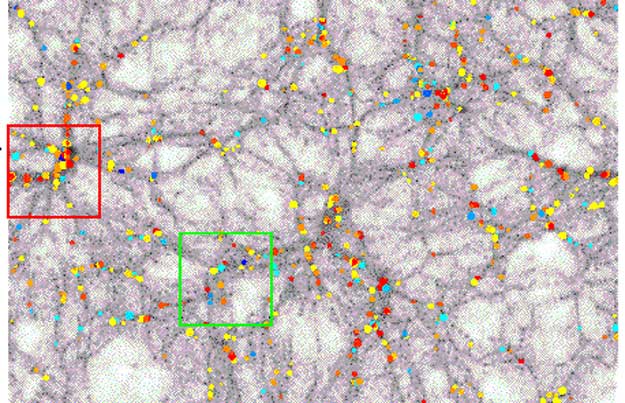
|
Explanation: Where is dark matter? Galaxies rotate and move in clusters as if a tremendous amount of unseen matter is present. But does dark matter exist in the greater universe too -- and if so, where? The answer can be found by comparing the distribution of galaxies observed with numerical simulations. This comparison became much more accurate recently when over 100,000 galaxy observations from the 2-Degree Field Galactic Redshift Survey were used. In the above frame from a computer simulation of our universe, a 300 million light-year slice shows dark matter in gray and galaxies as colored circles. The red box indicates the location of a rich cluster of galaxies, while the green box shows a more typical cross-section of our universe. Analyses indicate that the immense gravity of the pervasive dark matter pulls normal matter to it, so that light matter and dark matter actually cluster together.
|
January February March April May June July August September October November December |
| |||||||||||||||||||||||||||||||||||||||||||||||||||||||
NASA Web Site Statements, Warnings, and Disclaimers
NASA Official: Jay Norris. Specific rights apply.
A service of: LHEA at NASA / GSFC
& Michigan Tech. U.
Based on Astronomy Picture
Of the Day
Publications with keywords: universe - dark matter - 2dF survey - simulation
Publications with words: universe - dark matter - 2dF survey - simulation
See also:
- APOD: 2024 December 1 Á Cosmic Latte: The Average Color of the Universe
- APOD: 2024 October 20 Á Dark Matter in a Simulated Universe
- APOD: 2024 July 1 Á Time Spiral
- APOD: 2024 January 1 Á NGC 1232: A Grand Design Spiral Galaxy
- APOD: 2023 December 31 Á Illustris: A Simulation of the Universe
- APOD: 2023 July 5 Á A Map of the Observable Universe
- APOD: 2023 June 29 Á A Message from the Gravitational Universe
